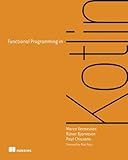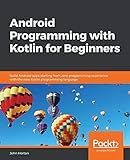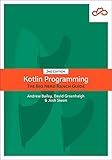Best Singleton Design Pattern Guides to Buy in November 2025

Kotlin in Action, Second Edition



Kotlin In-Depth: A Guide to a Multipurpose Programming Language for Server-Side, Front-End, Android, and Multiplatform Mobile (English Edition)



Head First Kotlin: A Brain-Friendly Guide



Functional Programming in Kotlin



Head First Android Development: A Learner's Guide to Building Android Apps with Kotlin



Kotlin Programming: Learning Guide Covering the Essentials and Advancing to Complex Concepts



Android Programming with Kotlin for Beginners: Build Android apps starting from zero programming experience with the new Kotlin programming language



Kotlin Design Patterns and Best Practices: Elevate your Kotlin skills with classical and modern design patterns, coroutines, and microservices



Kotlin Programming: The Big Nerd Ranch Guide (Big Nerd Ranch Guides)



Kotlin from Scratch: A Project-Based Introduction for the Intrepid Programmer


In Kotlin, implementing the Singleton pattern is quite straightforward. Here's how you can do it:
- Create a class and mark its constructor as private to prevent direct instantiation from outside the class. class Singleton private constructor() { // Singleton logic goes here }
- Declare a companion object within the class to provide a global point of access to the instance of the class. class Singleton private constructor() { companion object { // Singleton instance } }
- Initialize the instance lazily using the by lazy delegate and the getInstance method within the companion object. class Singleton private constructor() { companion object { val instance: Singleton by lazy { Singleton() } fun getInstance(): Singleton { return instance } } }
By utilizing the by lazy delegate, the instance will be initialized only when it's accessed for the first time.
- Now, you can access the Singleton instance anywhere in your code using the getInstance method. val singletonInstance = Singleton.getInstance()
That's it! You have implemented the Singleton pattern in Kotlin. This ensures that only one instance of the class will ever exist throughout the application.
How to handle exceptions in Singleton instances in Kotlin?
In Kotlin, you can handle exceptions in Singleton instances in the following ways:
- Use the try-catch block: Wrap the code that can potentially throw an exception in the try block, and catch the specific exception in the catch block. You can log the error or handle it appropriately within the catch block. For example:
object MySingleton { fun someFunction() { try { // Code that can potentially throw an exception } catch (e: Exception) { // Handle the exception println("Exception occurred: ${e.message}") } } }
- Use the Kotlin runCatching function: This function allows you to catch exceptions and handle them using the Result class. You can provide a lambda function or a block of code to the runCatching function, and handle the success or failure cases using the onSuccess and onFailure functions. For example:
object MySingleton { fun someFunction() { val result = runCatching { // Code that can potentially throw an exception }
result.onSuccess {
// Handle success case
println("Result: $it")
}.onFailure {
// Handle failure case
println("Exception occurred: ${it.message}")
}
}
}
By using either of these approaches, you can ensure that exceptions in Singleton instances are caught and handled appropriately, preventing the application from crashing.
How to create a Singleton instance in Kotlin?
To create a Singleton instance in Kotlin, you can use the object keyword instead of the class keyword. Here's an example:
object MySingleton { // properties and methods of the singleton instance private var count = 0
fun incrementCount() {
count++
}
fun getCount(): Int {
return count
}
}
In this example, MySingleton is a Singleton instance with a private property count and two methods: incrementCount() and getCount(). The object keyword ensures that there is only one instance of the object throughout the application.
You can then access the properties and methods of the Singleton instance by just using its name, like this:
MySingleton.incrementCount() println(MySingleton.getCount()) // Output: 1
Since the Singleton instance is created lazily, it is initialized the first time it's accessed and the same instance can be accessed from anywhere in the code.
What is a double-checked locking in Singleton pattern?
Double-checked locking is a technique used in the Singleton design pattern to improve performance by minimizing synchronization overhead.
In a multi-threaded environment, multiple threads may try to access the Singleton instance simultaneously. Without proper synchronization, this could lead to multiple instances being created, which breaks the Singleton pattern.
To address this, the double-checked locking technique is introduced. It involves checking if an instance of the Singleton has already been created outside of the synchronized block. If not, the synchronized block is entered to create the Singleton instance. This way, only the first thread that accesses the Singleton needs to acquire the lock, while subsequent threads can directly get the instance without entering the synchronized block, improving performance.
However, implementing double-checked locking correctly is not straightforward in all programming languages and runtime environments. It requires ensuring that memory visibility is properly handled, and it is prone to subtle issues related to compiler optimizations and memory models.
Note: From Java 5 onwards, the volatile keyword, along with the use of synchronized block or method, is recommended to implement a Singleton pattern, as it ensures memory visibility properties and thread-safe initialization without relying on double-checked locking.
What are the advantages of using a Singleton pattern?
The Singleton pattern offers several advantages:
- Single instance: It ensures that only one instance of a class is created and provides a global point of access to it. This is useful when only one instance is required throughout the application, such as a global configuration or a shared resource.
- Global access: The Singleton instance can be accessed from anywhere within the application, making it easy to use and retrieve the required object without passing it as a parameter or creating new instances.
- Resource sharing: Singleton allows multiple objects to interact with a shared resource, preventing the overuse or misuse of the shared resource. It ensures that multiple instances do not create conflicts or inconsistencies when accessing or modifying the shared resource.
- Lazy initialization: Singleton can be lazily instantiated, meaning that the instance is created only when it is first needed. This can be beneficial for performance and memory efficiency in cases where the instance is resource-consuming.
- Thread safety: By using synchronization techniques or thread-safe initialization, the Singleton pattern ensures that the instance creation is thread-safe. It prevents multiple threads from concurrently creating multiple instances, which can lead to race conditions or inconsistent behavior.
- Easy to implement and extend: The Singleton pattern is relatively easy to implement and understand. It also allows easy extension and inheritance if there is a need to modify or customize the behavior of the singleton instance.
- Control over object creation: By encapsulating the creation and access of the instance within the Singleton pattern, it provides control over how and when the instance is created, ensuring that it follows specific rules or restrictions.
However, it is important to use the Singleton pattern judiciously and consider its potential disadvantages, such as tight coupling and potential for global state abuse.
